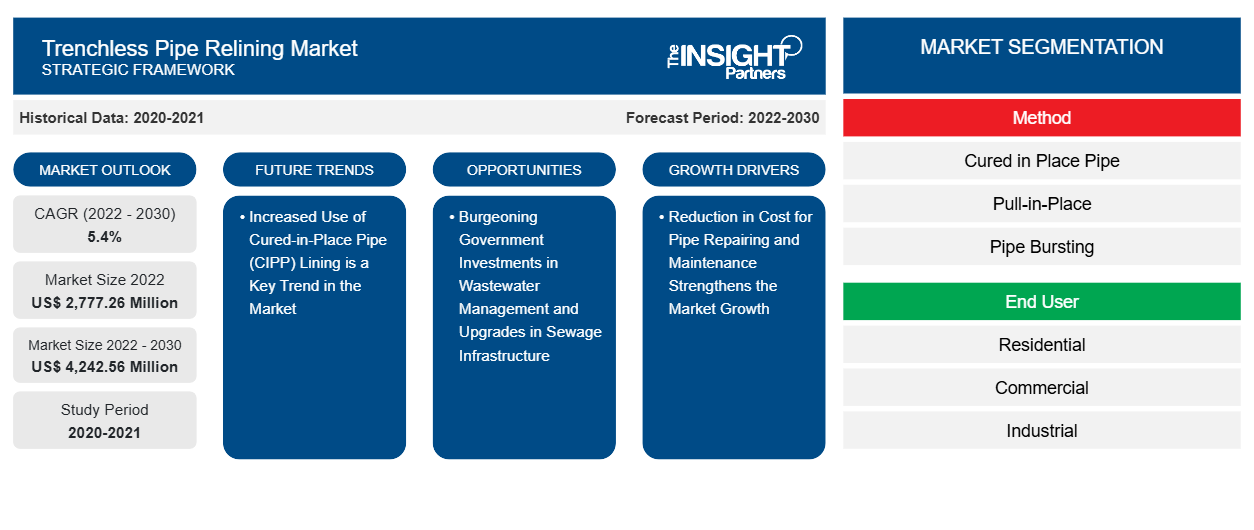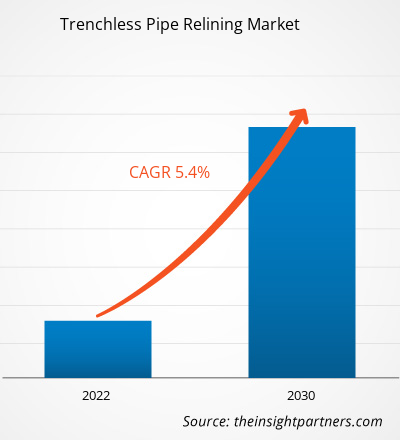The trenchless pipe relining market size is expected to reach US$ 5,001.55 million by 2031 from US$ 3,164.24 million in 2024. The market is estimated to register a CAGR of 6.86% during 2025–2031. The rising pipe rehabilitation demand worldwide is likely to bring new trends to the market in the coming years.
Trenchless Pipe Relining Market Analysis
The increase in aging pipeline infrastructures, rising urbanization and population growth, environmental regulations, surging number of wastewater pipeline networks, and stringent regulations on leakage and maintenance of pipeline networks are among the key factors driving market growth. Further, huge cost-benefits associated with trenchless pipe relining, such as reduced labor costs and a timeline for reviving the pipelines, are projected to provide lucrative opportunities to the market during the forecast period. The introduction of robotics in trenchless pipe relining is expected to emerge as a trend in the trenchless pipe relining market during 2025–2031.
Trenchless Pipe Relining Market Overview
Trenchless pipe relining, commonly referred to as trenchless pipe rehabilitation, is an innovative methodology used to restore aged and deteriorated pipelines without digging. Trenchless technology is an underground construction method of installing, repairing, and renewing underground pipes, ducts, and cables using techniques that minimize or eliminate the need for excavation. Trenchless projects are less hazardous to workers, as this technology allows processes to be controlled from the surface. Trenchless pipe relining is used in many infrastructure applications, including water, gas, sewer, pipelines, power, and communications. The market analysis on trenchless relining of water and sewer pipes is studied for residential, commercial, industrial, and municipal applications.
The continuous advancement of technology has resulted in the development of superior equipment and technology-driven solutions for pipe relining. Among these, the cured-in-place pipe relining (CIPP)-based solution type is extensively used over the conventional pipeline repair process. It offers evolutionary advantages in terms of costs, efforts, and efficiency of pipeline repair when compared with traditional methods that involve digging out the damaged pipes. Furthermore, other solution types, such as pull-in-place, pipe bursting, and internal pipe coating, have witnessed notable adoption across different industry verticals over the years.
Customize This Report To Suit Your Requirement
You will get customization on any report - free of charge - including parts of this report, or country-level analysis, Excel Data pack, as well as avail great offers and discounts for start-ups & universities
Trenchless Pipe Relining Market: Strategic Insights

-
Get Top Key Market Trends of this report.This FREE sample will include data analysis, ranging from market trends to estimates and forecasts.
Trenchless Pipe Relining Market Drivers and Opportunities
Stringent Regulations for Leakage and Maintenance of Pipeline Networks
Leakage from pipelines can cause significant environmental damage and economic losses. While pipelines were designed and constructed to maintain integrity, it is difficult to avoid leakage in a pipeline system during its lifetime. Enabling methods to reduce the event of leakages is necessary to minimize damage. Thus, governments of several countries have imposed strict regulations regarding the maintenance of pipeline networks. A few instances are mentioned below.
- Federal and state agencies regulate pipelines across the US. Interstate pipelines are managed by the Federal Energy Regulatory Commission (FERC) and the US Department of Transportation (DOT). The Federal Energy Regulatory Commission regulates pipelines, maintains storage, and monitors natural gas transportation in interstate commerce and liquefied natural gas facilities. It also oversees the operation of pipeline facilities at the US points of entry for natural gas imports and exports and analyzes the environmental impacts of natural gas projects.
- Federal legislation establishes the guidelines for Canadian Drinking Water Quality (GCDWQ). Federal representatives from departments are responsible for producing and providing safe and reliable drinking water in Canada.
- After the recommendation from the National Infrastructure Commission, water companies in the UK committed to a 50% reduction in leakage compared to 2017–2018 levels by 2050.
Such government initiatives to minimize leakage and maintain pipeline networks propel the adoption of trenchless pipe relining solutions, fueling the growth of the trenchless pipe relining market.
Rapid Urbanization and Smart Cities Development
Global urbanization trends and smart city initiatives are creating unprecedented demand for efficient infrastructure solutions that minimize urban disruption, positioning trenchless technologies as essential components of modern urban development. The United Nations projects that the global urban population will reach 68% by 2050, emphasizing the critical need for sustainable infrastructure solutions to accommodate this growth without disrupting existing urban environments. Smart city initiatives worldwide drive significant demand for trenchless technologies as urban areas seek sustainable infrastructure solutions that can accommodate advanced telecommunications, utilities, and monitoring systems. India's Smart Cities Mission was extended until March 2025, with several states requesting additional funds for ongoing projects. This exemplifies the growing trend toward developing smart urban infrastructure. The integration of trenchless methods with smart city planning allows for the efficient installation of fiber optic networks, underground power systems, and advanced water management infrastructure without the surface disruption that traditional methods require. Southeast Asia's rapid urbanization and increasing water and wastewater infrastructure needs have driven remarkable growth in the trenchless industry, with governments prioritizing these technologies through substantial funds allocated for water supply and sewerage projects.
Trenchless Pipe Relining Market Report Segmentation Analysis
Key segments that contributed to the derivation of the trenchless pipe relining market analysis are method, diameter, end user, and curing method.
- In terms of method, the market is categorized into cured in place pipe (CIPP), pull-in-place, pipe bursting, and internal pipe coating. The cured in place pipe (CIPP) segment dominated the trenchless pipe relining market in 2024.
- By diameter, the market is categorized into below DN 50, DN 51–DN 150, DN 151–DN 250, and above DN 251. The below DN50 segment dominated the market in 2024.
- Based on end user, the market is divided into residential, commercial, industrial, and municipal. The municipal segment dominated the market in 2024.
- Based on curing method, the market is divided into ambient cure, steam cure, hot water cure, and UV light cure. The hot water cure segment dominated the market in 2024.
Trenchless Pipe Relining Market Share Analysis by Geography
The trenchless pipe relining market is segmented into five major regions: North America, Europe, Asia Pacific (APAC), the Middle East and Africa (MEA), and South and Central America (SAM). North America dominated the market in 2024, followed by Asia Pacific and Europe.
A majority of underground water pipes constructed across North America have passed their estimated life span, resulting in severe consequences. According to American Water Works, 44% of water infrastructure in the US is of poor quality. Also, as per the American Society of Civil Engineers' estimation, approximately 240,000 water main breaks occur annually in the region. These failing conditions of the pipes lead to a shortage of clean water, affecting people's health. Thus, the growing aging pipe infrastructure in the region compels governments of various North American countries, such as the US, Canada, and Mexico, to repair and maintain it. To cater to this, governments of these countries are opting for different trenchless pipe relining methods for better functionality of the infrastructure. In February 2023, GE Research, Warren Environmental, and Garver announced their plans to conduct in-ground field tests with their newly developed PLUTO system. This system can help in the flexible deployment of sprayed-in-place pipe (SIPP) over long distances and at different diameters from a single excavation. Thus, soaring product innovation by the market players in the region is expected to create growth opportunities for the market in the future.
Trenchless Pipe Relining Market Regional InsightsThe regional trends and factors influencing the Trenchless Pipe Relining Market throughout the forecast period have been thoroughly explained by the analysts at The Insight Partners. This section also discusses Trenchless Pipe Relining Market segments and geography across North America, Europe, Asia Pacific, Middle East and Africa, and South and Central America.
Trenchless Pipe Relining Market Report Scope
| Report Attribute | Details |
|---|---|
| Market size in 2024 | US$ 3,164.24 Million |
| Market Size by 2031 | US$ 5,001.55 Million |
| Global CAGR (2025 - 2031) | 6.86% |
| Historical Data | 2021-2023 |
| Forecast period | 2025-2031 |
| Segments Covered |
By Method
|
| Regions and Countries Covered |
North America
|
| Market leaders and key company profiles |
|
Trenchless Pipe Relining Market Players Density: Understanding Its Impact on Business Dynamics
The Trenchless Pipe Relining Market is growing rapidly, driven by increasing end-user demand due to factors such as evolving consumer preferences, technological advancements, and greater awareness of the product's benefits. As demand rises, businesses are expanding their offerings, innovating to meet consumer needs, and capitalizing on emerging trends, which further fuels market growth.

- Get the Trenchless Pipe Relining Market top key players overview
Trenchless Pipe Relining Market News and Recent Developments
The trenchless pipe relining market is evaluated by gathering qualitative and quantitative data post primary and secondary research, which includes important corporate publications, association data, and databases. A few of the key developments in the trenchless pipe relining market are listed below:
- United Felts, a Vortex Company and industry-leading manufacturer of liners for trenchless rehabilitation, has announced a comprehensive rebrand of its breakthrough CIPP (Cured-in-Place Pipe) technology for potable water applications. Formerly known as CIPP H2O, the product will now be marketed under the name UnitedBLUE, specifically designed for watermain renewal. This rebrand follows the successful launch of the Vortex Water division, dedicated to solving the critical challenges posed by aging water infrastructure worldwide. (Source: Vortex Company, Press Release, June 2025)
- Waterline Renewal Technologies, a leader in innovative pipeline rehabilitation solutions, announced the introduction of LightRay High Temperature UV resin, a new high-performance UV-cured in-place pipe (CIPP) resin. This advanced resin is specifically designed for high-temperature applications and is compatible with all LightRay systems, marking a significant advancement in the CIPP industry. (Source: Waterline Renewal Technologies, Press Release, April 2025)
Trenchless Pipe Relining Market Report Coverage and Deliverables
The "Trenchless Pipe Relining Market Size and Forecast (2021–2031)" provides a detailed analysis of the market covering the areas mentioned below:
- Trenchless pipe relining market size and forecast at global, regional, and country levels for all the key market segments covered under the scope
- Trenchless pipe relining market trends, as well as market dynamics such as drivers, restraints, and key opportunities
- Detailed PEST and SWOT analysis
- Trenchless pipe relining market analysis covering key market trends, global and regional framework, major players, regulations, and recent market developments
- Industry landscape and competition analysis covering market concentration, heat map analysis, prominent players, and recent developments for the trenchless pipe relining market
- Detailed company profiles
Frequently Asked Questions
What are market opportunities for the trenchless pipe relining market?
Which region to dominate the trenchless pipe relining market in the forecast period?
What is the future trend for the trenchless pipe relining market?
Who are the major vendors in the trenchless pipe relining market?
What are reasons behind the trenchless pipe relining market growth?
- Historical Analysis (2 Years), Base Year, Forecast (7 Years) with CAGR
- PEST and SWOT Analysis
- Market Size Value / Volume - Global, Regional, Country
- Industry and Competitive Landscape
- Excel Dataset
Recent Reports
Testimonials
Reason to Buy
- Informed Decision-Making
- Understanding Market Dynamics
- Competitive Analysis
- Identifying Emerging Markets
- Customer Insights
- Market Forecasts
- Risk Mitigation
- Boosting Operational Efficiency
- Strategic Planning
- Investment Justification
- Tracking Industry Innovations
- Aligning with Regulatory Trends





















 Get Free Sample For
Get Free Sample For